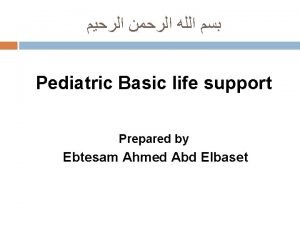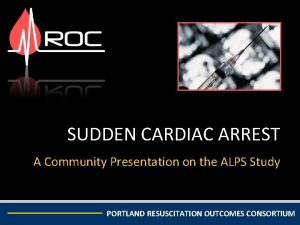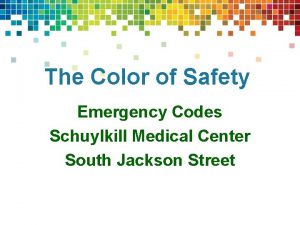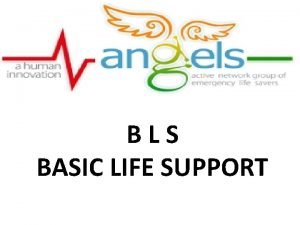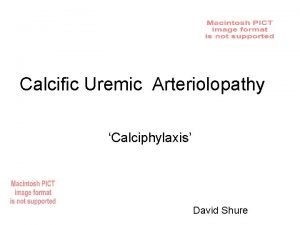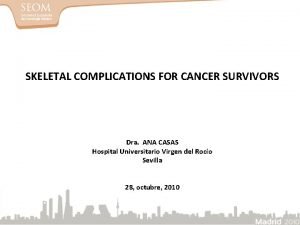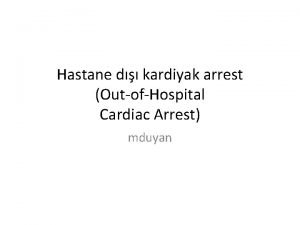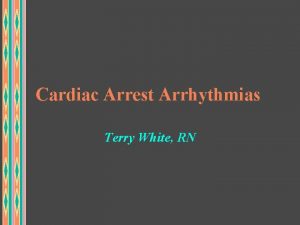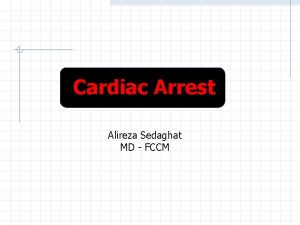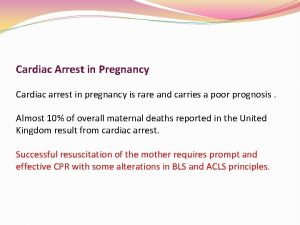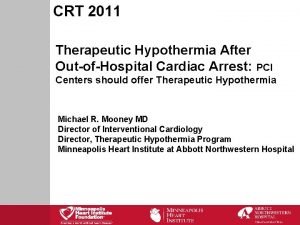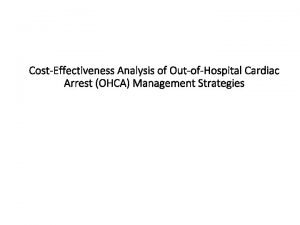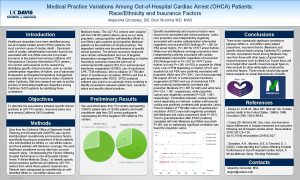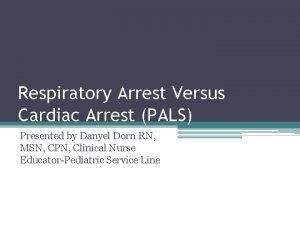Outofhospital cardiac arrest survivors sent for emergency angiography













- Slides: 13

Out-of-hospital cardiac arrest survivors sent for emergency angiography: a clinical score for predicting acute myocardial infarction Floriane Zeyons, Laurence Jesel, Olivier Morel, Hélène Kremer, Nathan Messas, Sebastien Hess, Ulun Crimizade, Philippe Reydel, Laurent Tritsch and Patrick Ohlmann - Eur Heart J Acute Cardiovasc Care. 2017 Mar; 6(2): 103 -111. Floriane Zeyons, MD University Hospital of Strasbourg, France

Introduction Out of hospital cardiac arrest (OHCA) High mortality : 90% of all OHCA, 75% when admitted alive to the hospital Cardiac origin : 70%, mainly acute myocardial infarction (AMI) Acute myocardial infarction (AMI): Better outcome with emergency angioplasty, the sooner the better The usual clinical and electrical signs may be absent => So, should all OHCA cases be immediately referred to the cath lab ?

Introduction Problem for the patient: Unnecessary procedure , potentially harmful Can delay some of the treatment, or other exams Problem for other patients : Risk of congesting the cath lab

Methods Retrospective, single center study Consecutive survivors of OHCA referred to the cath lab between 2009 and 2013 Analysis : Initial ECG from the SMUR unit (mobile emergency medical system) In hospital medical and biological findings Results of the coronary angiogramm 3 groups of patients : Group 1 : AMI related OHCA Groupe 2 : Chronic CAD related OHCA Group 3 : Non CAD related OHCA Objective : To identify predictors of AMI among survivors of OHCA

General results 177 patients included Group 1 : 76 (43%) – Group 2 : 27 (15%) – Group 3 : 74 (42%) PCI : 95 (54%) Group 1 : 95% Group 2 : 67% Group 3: 8% Survival rate 33% Group 1: 41% Group 2 : 44% Group 3 : 22%

Results : clinical characteristics

Results : ECG findings

Results : predictors of AMI

Results : AMI diagnostic score Item Number of points Chest pain before the arrest 1 Shockable initial rhythm 1 ST-segment elevation in any lead (including a. VR) 2 >1 >2 >3 >0

Discussion 1 The rate of AMI (43%) and CAD (73%) in our population is coherent with other studies Only 54% of the patients received PCI Group 3 : Although in the end CAD was not the cause of the arrest, 8% had PCI => excessive treatment ?

Discussion 2 Using an extended definition of ST elevation to include lead a. VR increases the sensitivity Added values of using the score: A) To rule out AMI : Score of 0 : low probability of AMI => ICU first, echocardiography, biology, etc… B) To better appreciate the likelihood of AMI High score=> insist on coronary angiogram before anything else. 2015 ESC guidelines : OHCA patients without a clear STEMI or ACS => short stop in the ICU/emergency room to rule out other causes of cardiac arrest

Discussion 3 Limitations of the study : Retrospective Coronary angiogramm registry Single center Limited number of patient

Take home messages AMI in only 43% of cases Look for ST elevation in a. VR The diagnostic score integrating chest pain before the arrest, a shockable initial rhythm, and ST elevation in any lead helps evaluate the likelihood of AMI With a score of 0, AMI is highly unlikely A stop to the ICU before rushing in the cath lab might be a valid strategy for those patients. Results need to be confirmed in a large-scale prospective study
 Causes of cardiac arrest
Causes of cardiac arrest Paediatric assessment triangle
Paediatric assessment triangle Cardiac arrest reason
Cardiac arrest reason Code green hospital
Code green hospital In hospital cardiac arrest chain of survival
In hospital cardiac arrest chain of survival Amiodarone mechanism of action
Amiodarone mechanism of action Pixel shifting
Pixel shifting Angiography equipment list
Angiography equipment list Thebasian veins
Thebasian veins Desert animals in australia
Desert animals in australia Survivors teaching students
Survivors teaching students Survivors sassoon analysis
Survivors sassoon analysis Calciphylaxis survivors
Calciphylaxis survivors Dra survivors
Dra survivors

